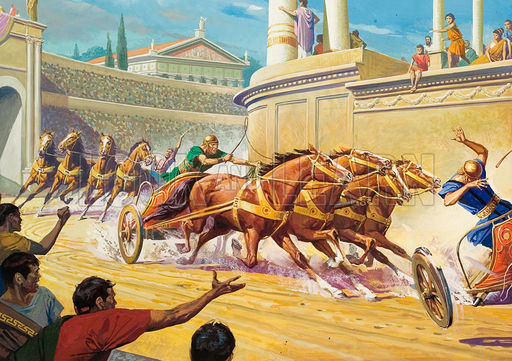
Gaius Appuleius Diocles won in 1462, and in 1437 races he came in second place. The arena of Circus Maximus had its great heroes. The coachmen wore a tunic in a colour matching the colours of the party they represented. The carriage took place in a standing position. Interestingly, in Rome, the exchange of players was also popular, as players now move to other clubs. During the race, in order not to let the reins go, they tied them up (and that’s why they always wore knives so that they could cut the reins in the event of an accident – which did not always work).ĭuring the races, there was often cooperation between individual teams to push one of the coachmen onto a spin. It happened, however, that some impoverished citizens decided on this path to gain wealth and fame. Most of the coachmen were recruited from slaves. They have often won a great fortune and worship of Roman women.
#CHARIOT RACES ANCIENT ROME DRIVERS#
The best drivers were great stars in Rome. Mosaic from the 3rd century CE showing a coachman with a horse. Importantly, each team had a maximum of three teams for each race. Participation in races made it easy to gain fame and money, but at the cost of a short life. ancient Roman games that have become widespread, especially as a result of popular. Based on the preserved inscriptions, the researchers calculated that the average age of the coachman participating in the chariot races in ancient Rome was 22 years.
#CHARIOT RACES ANCIENT ROME PDF#
The viewer who thought that the race should be repeated got up and waved his gown or tunic – when the majority did, the race was interrupted and repeated. PDF On Jan 1, 2014, Sinclair Bell published Roman Chariot-Racing. Due to the colour of the carriage drivers’ tunes, parties were formed among the audience, whose members often behaved similarly to modern football fans. Certainly, the most popular factions were the Blues and Greens – supported by the Emperor’s entourage – as evidenced by the small number of sources regarding Red and White.īut where exactly did these colours represent the teams? In the third century CE, Tertullian mentioned that the Reds were consecrated to Mars, the White Marshmallow, the Greens to Mother Earth or spring, and the Blue to sky and sea or autumn 1.Īs a curiosity, it is worth mentioning that the admirer of green was emperor Caligula, who spent hours sitting in their stables. In the times of Domitian, two additional teams were introduced: Purple and Gold but soon after his death in 96 CE, they disappeared. In ancient Rome, four fan clubs were classically distinguished: Red ( russata), Green ( prasina), White ( albata) and Blue ( veneta).

The fans were divided into specific factions ( factiones), depending on the colours. In addition to gladiatorial fights, the Romans also loved horse racing.


 0 kommentar(er)
0 kommentar(er)
